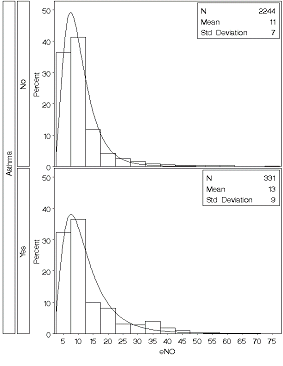2005 Progress Report: Air Pollution, Exhaled Breath Markers, and Asthma in Susceptible Children
EPA Grant Number: R831861C003Subproject: this is subproject number 003 , established and managed by the Center Director under grant R831861
(EPA does not fund or establish subprojects; EPA awards and manages the overall grant for this center).
Center: USC Center for Children’s Environmental Health
Center Director: Gilliland, Frank
Title: Air Pollution, Exhaled Breath Markers, and Asthma in Susceptible Children
Investigators: Gilliland, Frank
Institution: University of Southern California
EPA Project Officer: Fields, Nigel
Project Period: November 1, 2003 through October 31, 2008
Project Period Covered by this Report: November 1, 2004 through October 31, 2005
RFA: Centers for Children's Environmental Health and Disease Prevention Research (2003)
Research Category: Children's Health , Health Effects
Description:
Objective:The objectives of this research project are to assess the following hypotheses:
Hypothesis 1 (H1): High ambient air pollution exposure is associated with chronic airway inflammation in children as indicated by elevated exhaled nitric oxide (eNO), a marker of airway inflammation and oxidative/nitrosative stress.
Hypothesis 2 (H2): Children’s susceptibility to airway inflammation and oxidative/nitrosative stress from ambient air pollution varies by nitric oxide synthase 1 (NOS1), NOS2, and NOS3, and GSTM1, GSTP1, NQO1, and HO-1 genotypes.
Hypothesis 3 (H3): Children with chronic airway inflammation, as indicated by elevated eNO, are at increased risk for new onset asthma.
We will assess our hypotheses by accomplishing the following specific aims:
Specific Aim 1 (SA1): Collect eNO from 3,000 children in the ongoing AIR study cohort.
Specific Aim 2 (SA2): Genotype the cohort of 3,000 children for functional polymorphism/haplotypes in the NOS1, NOS2, and NOS3, and GSTM1, GSTP1, NQO1, and HO-1.
To assess H1 and H2:
Specific Aim 3 (SA3): To use a multilevel design to determine the relationship between levels of eNO with short- and long-term air pollution exposures and to assess the effects of genetic variation in NOS 1, NOS2, and NOS3 on these relationships using data collected in SA1, SA2, and air pollution exposure estimates from the ongoing cohort study.
To assess H3:
Specific Aim 4 (SA4): To determine the risk for new onset asthma in children with high levels of eNO using data collected in SA1 and in the ongoing prospective cohort study of incident asthma.
Progress Summary:In this period, we have developed protocols for field collection, tested methods, and trained field staff. We have completed fieldwork for enrolling subjects in the study and collecting eNO. We are beginning analysis of the data. Buccal cells for DNA were collected, processed, and stored in the Molecular Biology Core. We developed nitric oxide synthase assays and are beginning to extract DNA in preparation for genotyping. We also continue to follow the cohort for asthma status and exposure variables. Figure 1 shows the preliminary distribution of eNO in the cohort (incomplete sample size because of data issues).
Significance
eNO has the potential for use in understanding asthma etiology, for identifying high-risk children, and for use as a marker of response in intervention studies. The program of innovative research proposed in this application builds on the results from studies in the initial 5 years of the Children’s Environmental Health Center, the population resource of a large, ongoing, prospective cohort study of the determinants of childhood asthma incidence, and an extensive, cutting-edge air pollution exposure assessment program to fill key research and public health needs efficiently.

Figure 1. Preliminary Distribution of eNO in the Cohort (Incomplete Sample Size)
Future Activities:We plan to continue analyzing the eNO data, complete DNA extraction and begin genotyping the cohort for the proposed genes, and continue developing exposure metrics as the exposure measurements become available. We plan to investigate the use of GIS methods to examine these data. We also plan to submit a manuscript on the determinants of eNO in this large population-based sample as our first paper.
Journal Articles on this Report: 1 Displayed | Download in RIS Format
| Other subproject views: | All 1 publications | 1 publications in selected types | All 1 journal articles |
| Other center views: | All 210 publications | 196 publications in selected types | All 193 journal articles |
| Type | Citation | ||
|---|---|---|---|
|
|
Gauderman WJ, Avol E, Gilliland F, Vora H, Thomas D, Berhane K, McConnell R, Kuenzli N, Lurmann F, Rappaport E, Margolis H, Bates D, Peters J. The effect of air pollution on lung development from 10 to 18 years of age. New England Journal of Medicine 2004;351(11):1057-1067. |
R831861 (2004) R831861 (2005) R831861C003 (2005) |
not available |
asthma, children, susceptibility, community, children’s health, health effects, risk assessment, airway disease, allergen, asthma, childhood respiratory disease, children’s environmental health, community-based intervention, outreach and education, respiratory problems,
,
ENVIRONMENTAL MANAGEMENT, Scientific Discipline, Health, RFA, Risk Assessment, Health Risk Assessment, Children's Health, Biochemistry, allergen, respiratory problems, children's environmental health, childhood respiratory disease, susceptibility, outreach and education, community-based intervention, airway disease, asthma
Relevant Websites:
http://www.usc.edu/schools/medicine/research/centers_programs/cehc/![]()
http://www.usc.edu/schools/medicine/departments/preventive_medicine/divisions/occupational/occ_environmental/cehc/index.html![]()
Progress and Final Reports:
2004 Progress Report
Original Abstract
Main Center Abstract and Reports:
R831861 USC Center for Children’s Environmental Health
Subprojects under this Center:
(EPA does not fund or establish subprojects; EPA awards and manages the overall grant for this center).
R831861C001 Urban Air Pollution and Persistent Early Life Asthma
R831861C002 Pollution-Enhanced Allergic Inflammation and Phase II Enzymes
R831861C003 Air Pollution, Exhaled Breath Markers, and Asthma in Susceptible Children
![[logo] US EPA](https://webarchive.library.unt.edu/eot2008/20081106012740im_/http://www.epa.gov/epafiles/images/logo_epaseal.gif)